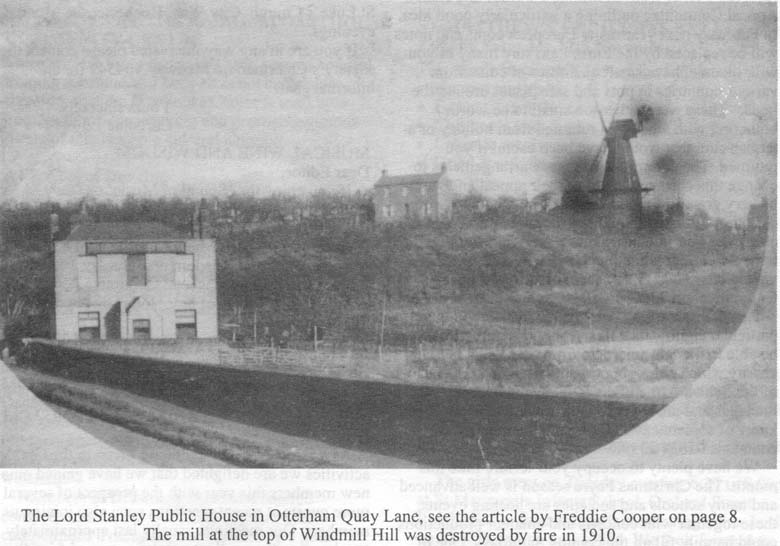THE LORD STANLEY
Action Forum, November 2001
In July a reader asked the editor if anyone knew the correct location of the Lord Stanley, a fair number responded, some were right some wrong. I started a search by visiting Peter Sargent who has recently transferred his Ordnance Survey Map business from Chatham to rooms above the Rainham Bookshop and obtained maps of this area dated back to 1801. I was fortunate enough to have the advice of my neighbour Mrs Ellen Tyler (née Swan) who spent her early life in Caroline Place, a terrace of 16 houses built by Eastwoods for their ‘Brickies’ on the road alongside the Three Sisters PH.
I learned a lot from my studies which I hope to share with readers later but none of this was as persuasive as the picture of the Lord Stanley which by chance I found on page 12 of the Rainham Red Book. This was apparently taken before 1910 as the Mill at the top of Windmill Hill is also in the picture at the bottom of the hill on a site which, I believe, is now occupied by a bungalow and various commercial undertakings. The ‘pub’ eventually became ‘Barnes Shop’ and a Mrs Beryl Shave wrote to explain that her mother, Mrs Minnie Hopper, now 93, was Mr Barnes’ daughter so I was able to ascertain family information at first hand. I was unable to find out when the ‘L.S.’ opened as a licensed house but understand that it was named after a Stanley Wakeley. It closed in 1918 when Mr Barnes opened the shop which subsequently served those living in the fairly isolated areas of Otterham, Upchurch, and Lower Halstow, first by horse and cart and later with a van. Mr Barnes died in 1956 but his daughter Ethel carried on the business until VAT was introduced and left the premises in 1980. The building remained empty for a period before, like the Mill at the hilltop, it was destroyed by fire.
Mrs Tyler also told me about Mr Richens, whose shop next to the Three Sisters PH was already established when Mr Barnes arrived in 1918. He supplied most general needs from meat to oil, in fact like most village ‘butchers’, he had a slaughter house at the top of the garden. We had one within 30 yards of the C of E School at the top of Station Road and our lessons or play were often accompanied by the squeal of pigs. One has to remember that there was a small general store in most roads for the odd daily purchase, we had no refrigerators or freezers and children were often sent for small quantities ‘on the slate’ (payable on pay day). I would presume that Otterham residents would have come by bus or bike to Rainham for their main purchases. Regular rounds by cart or van were made by milkmen, bakers, greengrocers, a fishmonger, and coalmen and, when in season, a shrimp and winkle man on a trandesman’s cycle clanging a bell before Sunday teatime. For those able to purchase fair quantities a boy would call from the International, Quinnells, or Roses on Thursdays for an order book for groceries to be delivered the following day. Although few lived in the immediate vicinity it is an indication of the number employed in the manufacture and distribution of bricks and cement that there were three ‘pubs’ in Otterham Quay around the turn of last century.
In addition to the Lord Stanley and the Three Sisters there was also the Anchor and Hope which was demolished in 1921 and a Working Men’s Club (period of activity unknown but I seem to remember it about 200 yards N.E. of the Three Sisters around the time of the last War). Incidentally the Three Sisters PH and all that side of Otterham Quay is in Upchurch (Swale), the boundary line runs roughly up the centre of the creek. I hope to write more about brick and cement making and barge transportation when Otterham was a hive of industry around the early 1900s in a later issue.
Freddie Cooper











































































































































